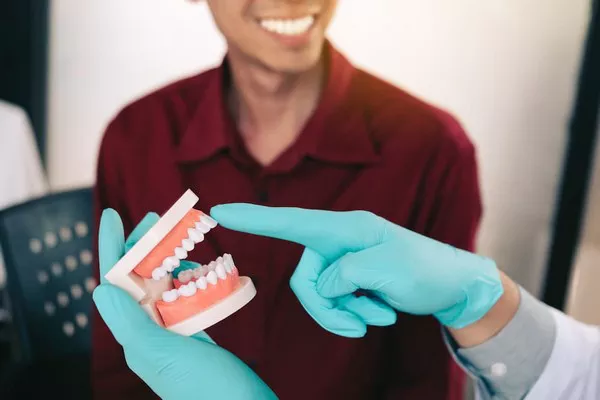Maintaining optimal oral health is crucial for overall well-being, and dental scaling is a fundamental procedure in achieving this. Scaling, also known as deep cleaning, plays a pivotal role in preventing and treating gum disease by removing plaque and tartar from the teeth and gums. This article provides how is scaling done, including its purpose, patient experience, preparation, aftercare, and benefits.
Procedure Overview
Initial Examination: Before the scaling procedure begins, a dental professional conducts a thorough examination of the patient’s oral health. This involves checking for signs of gum disease, measuring pocket depths around the teeth, and assessing the amount of plaque and tartar buildup.
Anesthesia: Depending on the extent of scaling required and the patient’s comfort level, local anesthesia may be administered to numb the gums and reduce discomfort.
Ultrasonic Scalers: The procedure typically starts with an ultrasonic scaler. This tool uses high-frequency vibrations to loosen and remove large deposits of plaque and tartar from the tooth surface. The ultrasonic scaler also sprays a cooling mist of water to wash away debris and keep the area clean.
Hand Instruments: After the bulk of the tartar is removed with the ultrasonic scaler, the dental professional will use hand instruments, such as scalers and curettes, to meticulously clean the tooth surfaces and root surfaces. These instruments allow for precise removal of any remaining plaque and tartar, especially in hard-to-reach areas.
Polishing: Once scaling is complete, the teeth are polished using a special paste. Polishing helps smooth the tooth surfaces, making it more difficult for plaque to adhere in the future and leaving the teeth with a clean, shiny finish.
Fluoride Treatment: In some cases, a fluoride treatment may be applied to the teeth after scaling to strengthen the enamel and help prevent decay.
Purpose of Scaling
Plaque and Tartar Removal: Plaque is a soft, sticky film of bacteria that forms on teeth and can lead to gum disease if not removed regularly. When plaque hardens, it becomes tartar, which can only be removed through professional cleaning. Scaling effectively eliminates both plaque and tartar, preventing the progression of gum disease.
Gum Health: By removing the buildup of plaque and tartar, scaling helps reduce inflammation and bleeding of the gums, promoting healthier gum tissue.
Preventing Tooth Loss:
Supporting Tooth Stability: Gum disease can lead to the destruction of the bone and tissues that support the teeth. By treating gum disease early through scaling, it is possible to preserve these structures and prevent tooth loss.
Improving Oral Hygiene:
Enhancing Home Care: After scaling, the teeth and gums are easier to clean through regular brushing and flossing, enhancing overall oral hygiene.
see also: Why Do My Teeth Look Yellow In The Morning
Patient Experience
Vibrations: Patients will feel vibrations from the ultrasonic scaler as it removes the tartar. This sensation is usually not painful but may feel a bit strange.
Water Spray: The cooling spray of water used during scaling helps flush out debris and keep the teeth and gums cool. Some patients might feel a bit of water in their mouth, which is typically suctioned away by the dental assistant.
Pressure: When hand instruments are used, patients might feel slight pressure as the dental professional scrapes away the tartar. Again, this should not be painful, especially if local anesthesia is used.
Preparation and Aftercare
Dental History: Be prepared to discuss your dental history, including any previous treatments for gum disease and any symptoms you are experiencing.
Oral Hygiene: Maintain good oral hygiene leading up to the appointment, but avoid vigorous brushing or flossing on the day of the procedure to prevent irritation.
Medications: Inform your dentist of any medications you are taking, as certain drugs can affect bleeding and healing.
Aftercare Recommendations:
Oral Hygiene: Continue brushing and flossing regularly, but be gentle around the gumline where scaling was performed. Use a soft-bristled toothbrush and follow any specific instructions given by your dentist.
Rinsing: Rinse your mouth with warm salt water to help soothe the gums and reduce inflammation. Your dentist may also recommend an antiseptic mouthwash.
Diet: Stick to soft foods for the first few days following the procedure to avoid irritating the gums. Avoid hot, spicy, or crunchy foods that might cause discomfort.
Pain Management: If you experience any discomfort, over-the-counter pain relievers such as ibuprofen can help. Follow the dosage instructions and consult your dentist if the pain persists.
Follow-Up: Attend any scheduled follow-up appointments to ensure that your gums are healing properly and to monitor your oral health.
see also: Why Is My Teeth Naturally Yellow
Benefits of Scaling
Reduced Inflammation: Scaling removes the irritants that cause gum inflammation, leading to healthier and less swollen gums.
Prevention of Gingivitis and Periodontitis: By eliminating plaque and tartar, scaling helps prevent and treat gingivitis (early stage of gum disease) and periodontitis (advanced stage).
Fresher Breath:
Eliminating Bacteria: Scaling removes bacteria that cause bad breath, resulting in a fresher mouth.
Enhanced Aesthetics:
Cleaner Appearance: The removal of tartar and stains through scaling leaves teeth looking cleaner and brighter.
Frequency of Treatment
Based on Oral Health: The frequency of scaling depends on an individual’s oral health status. Patients with healthy gums may only need scaling during their regular dental check-ups every six months.
Gum Disease: Patients with gum disease may require more frequent scaling, such as every three to four months, to keep the condition under control.
Consult Your Dentist: It is important to follow the schedule recommended by your dentist or dental hygienist to maintain optimal oral health.
Consultation with a Dental Professional
Addressing Concerns: If you have any concerns about gum disease or the scaling procedure, consulting with a dental professional is essential. They can provide personalized advice based on your specific oral health needs.
Treatment Planning: Your dentist will create a treatment plan tailored to your condition, ensuring that you receive the care necessary to maintain healthy teeth and gums.
Regular Monitoring:
Preventive Care: Regular dental visits allow your dentist to monitor your oral health, detect any issues early, and provide preventive care to avoid the progression of gum disease.
Conclusion
Scaling is a crucial dental procedure that helps maintain oral health by removing plaque and tartar, preventing gum disease, and promoting healthier teeth and gums. Understanding the scaling process, its benefits, and proper aftercare can help patients feel more comfortable and confident about their dental care. Regular dental visits and consultations with a dental professional are essential for personalized advice and ongoing oral health maintenance. By prioritizing scaling and other preventive measures, individuals can enjoy a cleaner, healthier, and more confident smile.
You Might Be Interested In





























